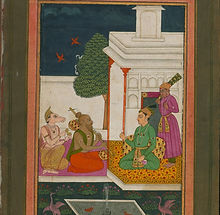Prastara
This term refers to the permutation of musical notes through all possible combinations.
Given the existence of seven fundamental notes, there are mathematically five thousand and forty (5040) different combinations that can be derived from this process.
This procedure is known as Prastāra, and each of these resulting combinations is referred to as Tāna.
However, if only six notes are taken into consideration, the potential combinations reduce to seven hundred and twenty (720).
For a group of five notes, there are one hundred and twenty (120) variations.
A group of four notes produces twenty-four (24) combinations.
A group of three notes can be arranged in six (6) different ways.
In the case of a group of two notes, only two (2) combinations are possible.
Clearly, with just a single note, there is only one possibility.
For example:
Sāmika Prastāra 3 notes:
- SRG, RSG, SGR, GSR, RGS, GRS
Svarātara Prastāra 4 notes:
1. SRGM
2. RSGM
3. SGRM
4. RGSM
5. GSRM
6. GRSM
7. SRMG
8. RSMG
9. SMRG
10. MSR
11. RMSG
12. MRSG
13. SGMR
14. GSMR
15. SMGR
16. MSGR
17. GMSR
18. MGSR
19. RGMS
20. GRMS
21. RMGS
22. MRGS
23. GMRS
24. MGRS
Prastāra 5 notes 120 combinations:
1.SRGMP 7.SRMGP 13.SGMRP 19.RGMSP
2.RSGMP 8.RSMGP 14.GSMRP 20.GRMSP
3.SGRMP 9.SMRGP 15.SMGRP 21.RMGSP
4. RGSMP 10.MSRGP 16.MSGRP 22.MRGSP
5.GSRMP 11.RMSGP 17.GMSRP 23.GMRSP
6.GRSMP 12.MRSGP 18.MGSRP 24.MGRSP
25.SRGPM 31.SRPGM 37.SGPRM 43.RGPSM
26.RSGPM 32.RSPGM 38.GSPRM 44.GRPSM
27.SGRPM 33.SPRGM 39.SPGRM 45.RPGSM
28. RGSPM 34.PSRGM 40.PSGRM 46.PRGSM
29.GSRPM 35.RPSGM 41.GPSRM 47.GPRSM
30.GRSPM 36.PRSGM 42.PGSRM 48.PGRSM
49.SRMPG 55.SRPMG 61.SMPRG 67.RMPSG
50.RSMPG 56.RSPMG 62.MSPRG 68.MRPSG
51.SMRPG 57.SPRMG 63.SPMRG 69.RPMSG
52. RMSPG 58.PSRMG 64.PSMRG 70.PRMSG
53.MSRPG 59.RPSMG 65.MPSRG 71.MPRSG
54.MRSPG 60.PRSMG 66.PMSRG 72.PMRSG
73.SGMPR 79.SGPMR 85.SMPGR 91.GMPSR
74.GSMPR 80.GSPMR 86.MSPGR 92.MGPSR
75.SMGPR 81.SPGMR 87.SPMGR 93.GPMSR
76. GMSPR 82.PSGMR 88.PSMGR 94.PGMSR
77.MSGPR 83.GPSMR 89.MPSGR 95.MPGSR
78.MGSPR 84.PGSMR 90.PMSGR 96.PMGSR
97.RGMPS 103.RGPMS 109.RMPGS 115.GMPRS
98.GRMPS 104.GRPMS 110.MRPGS 116.MGPRS
99.RMGPS 105.RPGMS 111.RPMGS 117.GPMRS
100. GMRPS 106.PRGMS 112.PRMGS 118.PGMRS
101.MRGPS 107.GPRMS 113.MPRGS 119.MPGRS
102.MGRPS 108.PGRMS 114.PMRGS 120.PMGRS
INDIAN CLASSICAL MUSIC LESSONS AND ONLINE COURSES
IN MODAL MUSIC, IMPROVISATION AND COMPOSITION
LEARN THE MAIN TECHNIQUES OF INDIAN MUSIC WITH A SIMPLE AND PERSONALIZED METHOD!
My online music lessons are the perfect way to learn to sing, or improve the vocal techniques already acquired, or to start playing your favorite instrument or progress in your musical path through an alternative teaching method to Western teaching.
The goal of my Indian classical music courses is to teach you the basics of this wonderful art form. You will learn about the various Ragas, or modal scales, the Talas or rhythmic cycles, and the vocal and instrumental techniques used for improvisation in Indian classical music.
What makes my approach to teaching indian classical music so distinctive?
My teaching system is obviously unique and different from others and I think that learning music following the traditional Indian approach is the most effective method regardless of genre: pop, jazz, world fusion, electronic, whatever musical style you if you are interested, I guarantee that thanks to the Indian perspective, you will have an edge over all the other musicians.
What will you learn?
During my lessons I use a variety of techniques and exercises to learn to improvise and compose. What you will learn in my Indian classical music courses will be based on the concepts of modal scale and rhythmic cycle, i.e. Raga and Tala. You will also learn vocal and instrumental techniques which, although based on Indian musical theory, also find application in the Western musical system.
Will the course suit you?
My courses are aimed to all musicians of all levels, beginners, intermediate and advanced, offering different study materials and techniques from the usual Western standards. All those who want to learn to play Indian classical music are welcome and no previous knowledge or experience is necessary to get started.
I can not wait to get to know you!
Contact me now! The first lesson is FREE!











%2018th-19th%20centuries%20b.jpg)




